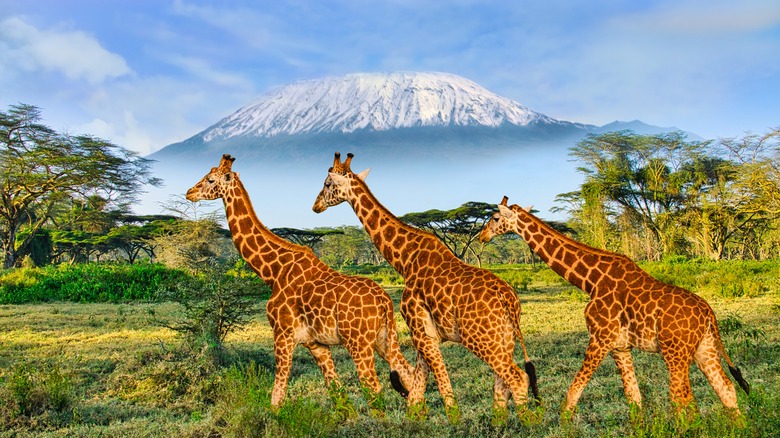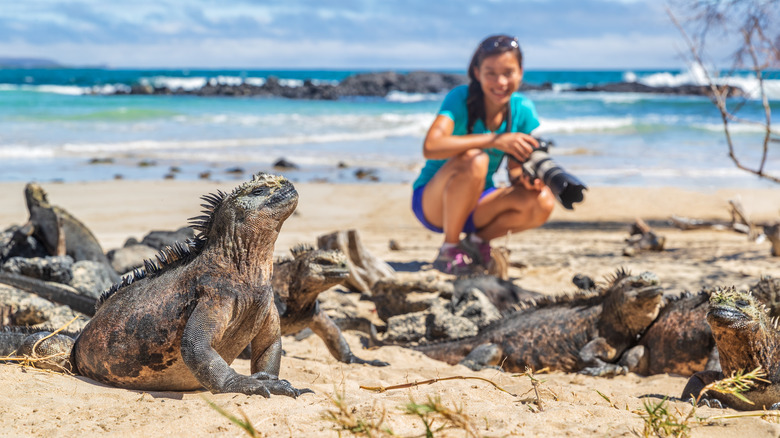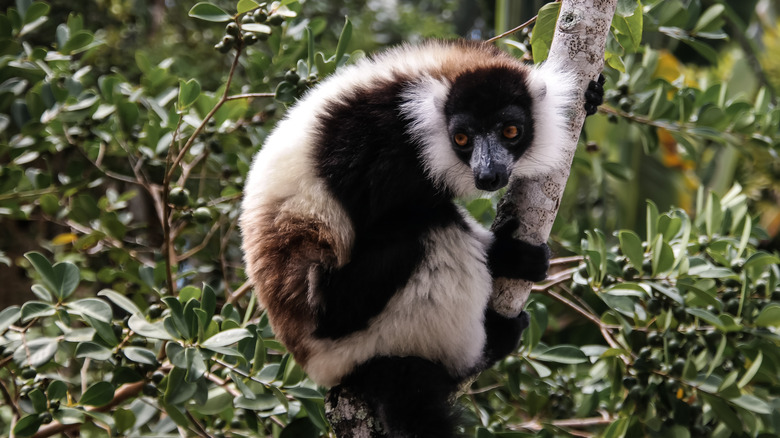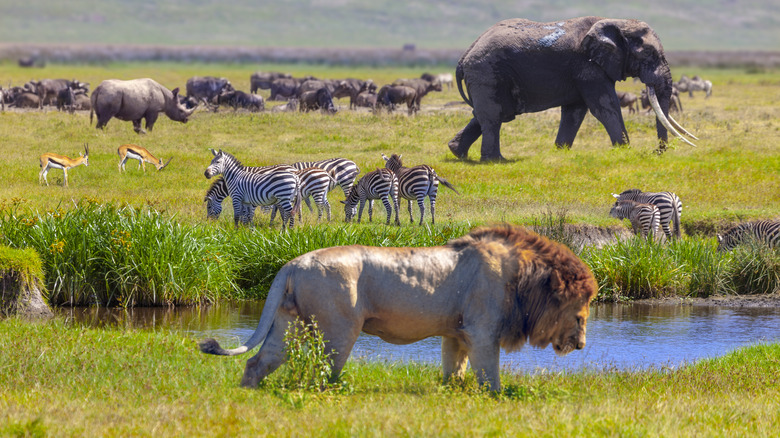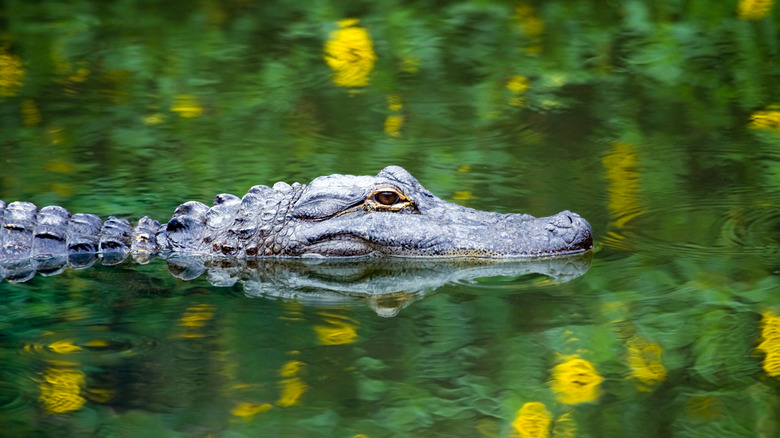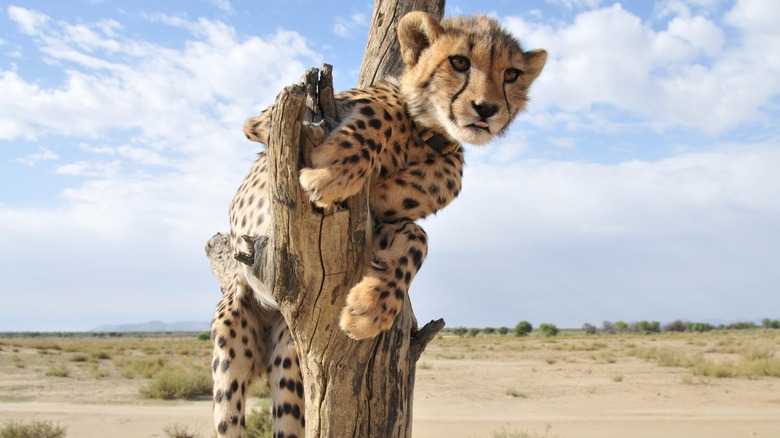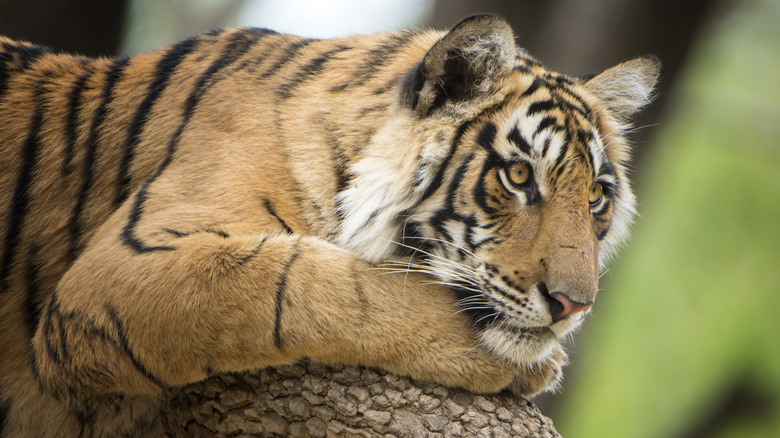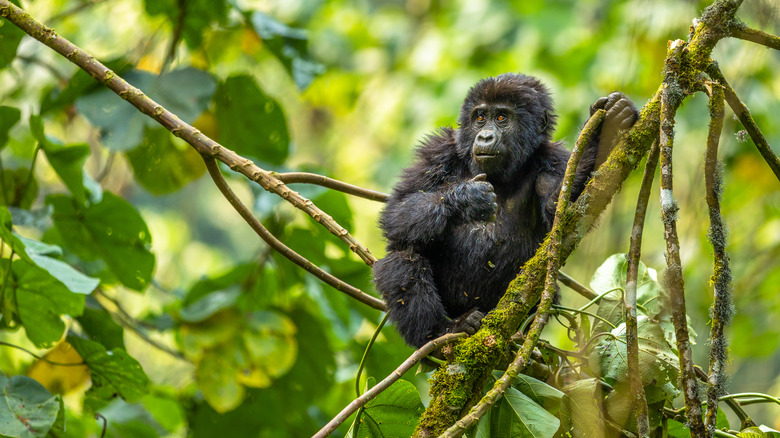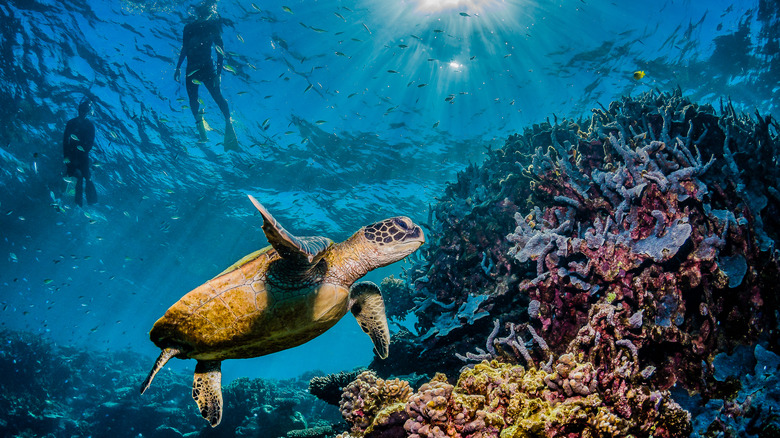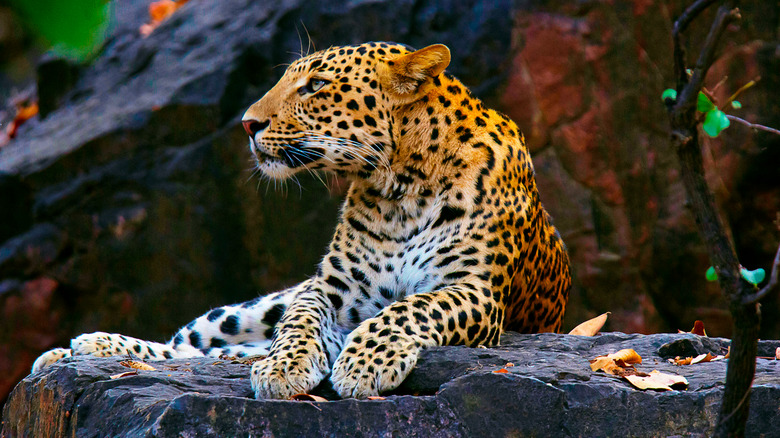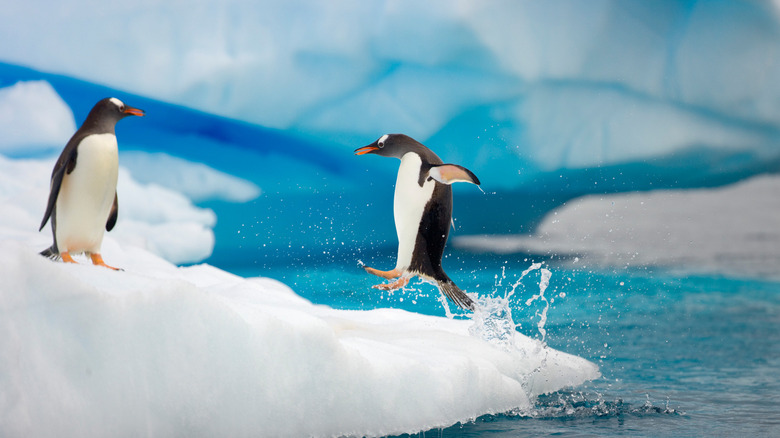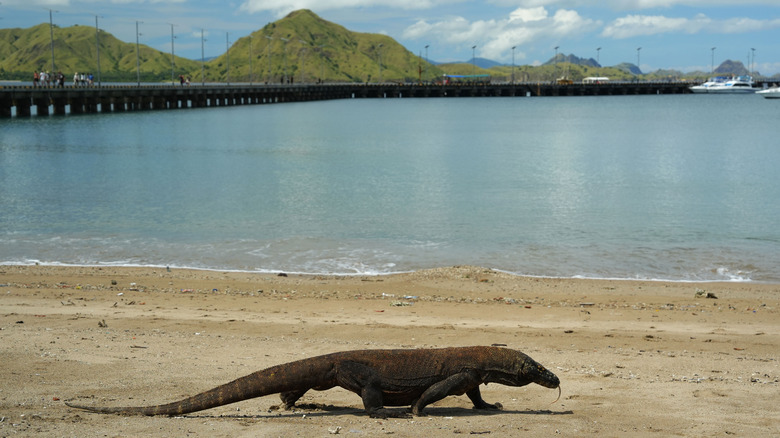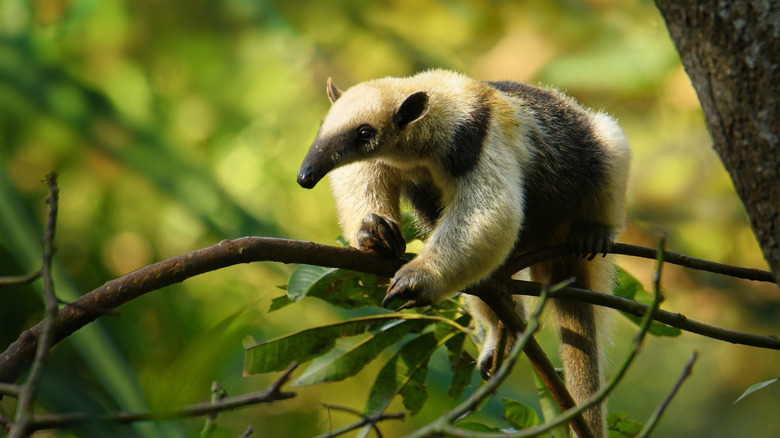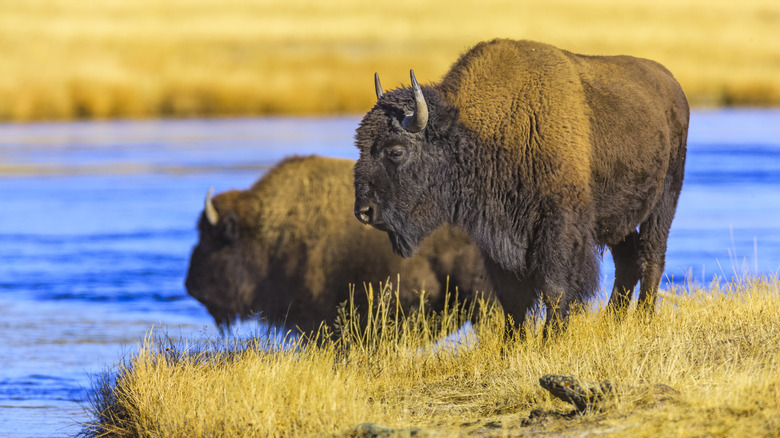Best Places For Spotting Rare Wildlife Up Close
Ever since early childhood, humans are taught all the mystical animals that live around the world but most of them never imagine they'll actually have the chance to come face-to-face with them. These fanciful creatures all seem so far away and inaccessible. Yet, there are over 2 million species on the planet waiting for you to catch a glimpse of them with your own eyes out in the wild. It is entirely within the realm of possibility with a little bit of preparation.
Nothing is stopping you from safely and ethically crossing paths with lions, gorillas, sharks, and more if you know how to plan the right trip to the ideal animal-sighting destination. The world is a big place, though, and you'll need a little bit of guidance to figure out where your favorite animals are hiding in it. No worries, though. All you have to do to find the perfect destination for your wildlife-sighting trip is read through these 13 best places for spotting rare wildlife up close.
Galapagos Islands (Ecuador)
When it comes to animal-heavy destinations, perhaps none is better known around the globe than the Galapagos Islands, 600 miles off the coast of Ecuador. Not only are the Galapagos Islands a legendary animal-spotting destination, but they also come with a fair amount of history. This place was the big inspiration behind Charles Darwin's theory of evolution and natural selection. After visiting the island, Darwin saw how the finch's beaks had adapted over time to help them live more efficiently in their environment and the discovery helped to explain a massive missing link in biology.
To this day, the Galapagos Islands are still inspiring people with their variety of incredibly rare land and sea species that you cannot find anywhere else on the planet. The only place in the world where Galapagos giant tortoises, Galapagos sea lions, marine iguanas, Darwin's finches, and blue-footed boobies exist are these islands. There are more than 9,000 species living either directly on the Galapagos Islands or in the nearby surrounding ocean.
If there are any particular species you specifically want to spot on a trip here, make sure you inquire with a tour provider in advance to coordinate the best season to visit the Galapagos Islands. It's a bit of a journey to actually reach the Galapagos Islands and it will require around two to three different flights. However, it's way worth it for science and animal enthusiasts.
Atsinanana Rainforests (Madagascar)
The Atsinanana Rainforests of Madagascar are comprised of six different wildlife-filled national parks that span nearly 995 gorgeous miles in total. Within those bounds is an otherworldly collection of wild animals and plant life. Atsinanana is a UNESCO World Heritage Site and one of the most biodiverse-rich places on the entire planet. It's actually the country's oldest rainforest, so there are quite a lot of unique critters roaming around these lands.
As such an important piece of nature, Atsinanana Rainforests is a highly protected area, but you can still visit the area as long as you take the proper preparations. There are several hotels available around the Atsinanana region and tours that make it possible to get familiar with Madagascar's wildlife safely. Inside the many miles of the national parks, you'll have the opportunity to spot a variety of animal friends. There are several different species of lemurs, geckos, chameleons, and birds living in the Rainforests of Atsinanana.
Serengeti National Park (Tanzania)
If you're dying to see all the big-name animals that always earn a spot on the favorites list, then you should get to work planning a visit to the Serengeti National Park in Tanzania. This place is so distinctive for its range of wildlife and diverse ecosystem that it's distinguished as a UNESCO World Heritage Site. The plains of the Serengeti encompass 5,700 square miles of raw nature that will give you the chance to see how African animals truly live in the wild.
On a safari through Serengeti National Park, you have a good shot at spotting 500 bird species, African elephants, buffalos, rhinoceros, lions, and leopards that freely roam this area. The Serengeti National Park dubs itself as a paradise for photography lovers and that assessment definitely seems fair. With all these intriguing creatures to see, it's no surprise that the Serengeti is one of the most popular places to go on safari vacations in the world.
Everglades (USA)
Don't worry, you can still see animals up close without a passport. There are lots of places with extraordinary wildlife in the United States, too – just take a look at the 1.5 million acres of the Everglades wetlands in southern Florida. The Everglades is home to a crazy (and frankly scary) amount of wildlife that you can get very close to.
The list of Everglades residents includes an assortment of unique fish, creepy crawlies like spiders and centipedes, panthers, bobcats, and dolphins. The most famous animal lurking in the depths of the Everglades are alligators and crocodiles. There are more than 200,000 alligators and 2,000 crocodiles that live here. While it's rare to actually become a snack for one of these giant reptiles and other animals in the Everglades, you still want to take precautions with so many deadly creatures around.
There are a bunch of ground rules for visiting this area that you'll definitely want to heed to avoid a dangerous situation. You should never get too close to any wildlife you see or their dens, even if you find a baby all alone — its defensive parent is likely nearby. It's also prohibited to feed anything to the animals in the Everglades.
Kruger National Park (South Africa)
If you've been searching for the ideal place to go on a safari, the answer you're looking for is probably Kruger National Park. It's the largest national park in South Africa and one of the biggest in the entire world. This nearly five-million-acre park offers visitors the chance to spot all types of animals up close. There is everything from the adorable ones to the vicious predators wandering around.
There are actually two different sections of Kruger National Park that each come with their own terrain and common animals. In the northern part of the park, you'll find mammals and a wide range of birds. However, it's in the southern portion of the park that you'll have a higher chance of spotting big cats like lions, cheetahs, and leopards. Throughout the park, it is also possible to get a close view of rhinos, hyenas, giraffes, hippos, zebras, monkeys, and more.
Your best chance at seeing the animals of Kruger will be with a guided safari that stops at all the known wildlife hotspots. Make sure you avoid the peak of the hot, dry season from July to September. You might get a bit too much of the nature experience if you visit at this time because it's more common to see dead animals around from the lack of water. Instead, try to visit at the very beginning or end of the dry season for ideal weather without it being too intense.
Ranthambore National Park (India)
The main animal that Ranthambore National Park in India is known for is its ferocious, enormous tigers. You have a better chance of spotting tigers here than anywhere else in the country. Nature photographers flock to Ranthambore for the chance to photograph these majestic beings. The most photographed tiger in the world, the Tigress Queen of Ranthambore or Machli, actually lived in this forest.
There are around 80 tigers (including around 32 cubs) in total living in the national park as of 2018. With its reputation for being such a tiger hub, nature and animal photographers flock to Ranthambore in the hopes that they'll get a one-of-a-kind shot of the big cats for their portfolio. Even if you're not a professional photographer, the opportunity to see tigers sauntering through their stomping ground is life-changing.
Tigers aren't the only animals that dominate Ranthambore National Park. There are other big predators in Ranthambore, like leopards, jackals, and hyenas. The park is also home to a bunch of other species as well, including 320 types of birds, 40 different mammals, and 35 kinds of reptiles.
Bwindi Impenetrable Forest (Uganda)
Let its name be a warning to you: the Bwindi Impenetrable Forest in Uganda is nothing to play around with. It is an extremely serious, dense woodland spanning over 123 square miles. Despite its dramatic terrain, Bwindi is absolutely teeming with so much biodiversity and wildlife that it's named a UNESCO site. There are 160 species of trees alone in this forest and that's just the trees!
The center of attention inside Bwindi Impenetrable Forest is its mountain gorillas. There are approximately 12 different families of gorillas who currently reside in this Impenetrable Forest. This figure includes around 400 individual gorillas in total, so there is a really good chance of getting a peek at them living life when you visit.
The mountain gorillas at Bwindi account for just a little less than half of the wild gorilla population on the planet right now to put it all in perspective. In addition to the large population of gorillas, ten other varieties of primates live at Bwindi, like baboons and golden monkeys. Along with different types of colorful butterflies, and birds that fly through the thick vegetation.
Great Barrier Reef (Australia)
Stunning wildlife sightings aren't simply possible on land — there is a new whole world of animals to visit in the seas. There is no better place on Earth to dive into the ocean world than the Great Barrier Reef on the eastern coast of Australia. The 1400+ mile underwater wonderland is one of the most popular locations for seeing scarce marine life and other sorts of oceanic wonders. There is a lot of animal activity buzzing around these waters with over 1,6000 species of fish swimming around.
When you go snorkeling or scuba-diving in the Great Barrier Reef, you'll witness animals like green turtles, manta rays, whale sharks, humpback whales, octopuses, jellyfish, and seals effortlessly floating around. You may even be lucky enough to swim by a strange creature called a Dugong that is almost exclusively found around the Great Barrier Reef. Oddly enough, this little guy is more genetically similar to elephants than sea creatures like whales.
The Great Barrier Reef is also home to a fairly large shark population. There are white-tip and black-tip reef sharks, tiger sharks, lemon sharks, whale sharks, and even the odd Tasselled Wobbegong Shark around these waters. In total, 180 species of shark can be found around the Great Barrier Reef. Despite this, it's still considered safe to swim around these waters and many people even relish the opportunity to spot one of these sharks that mainly mind their own business.
Yala National Park (Sri Lanka)
The South Asian island of Sri Lanka is the homeland for a great deal of diverse wildlife and most of these animals can be found right in Yala National Park. The biggie here is leopards – there is a leopard every 2.5 square miles in Yala. Even though these big cats can be found in other places, Yala has a higher density of leopards than anywhere else on Earth. The best time to spot them is during the mornings and evenings and you may even be able to witness them hunting down deer and wild boar.
Once you've gotten your fill of leopards, keep an eye out for the many other animals that live in Yala National Park. There is a pretty big Sri Lankan elephant population in the area, with around 300 to 350 elephants roaming around. Additionally, there are animals like wild peacocks, monitor lizards, jackals, and sloth bears.
Antarctic Peninsula (Antarctica)
While most wildlife destinations are in intensely hot places, that isn't always the case. On the other end of the wildlife spectrum, there is the freezing-cold, magical land of Antarctica. The Antarctic Peninsula hosts a thriving population of cold-weather animals that's pretty accessible for human visitors these days. In this region, you'll get to watch different types of penguins dive into the frigid waters, leopard seals glide belly-first along the ice, and humpback and killer whales curiously poke their heads out of the slush to say hello.
This remote continent is basically impossible to reach on your own, which is likely why so many rare species flourish without disturbance here. Thanks to the modern travel era, though, it's never been more straightforward to visit Antarctica and all its unique animals that you can't find anywhere else. To get a peak, you'll have to join an organized cruise from Argentina that will can you out to the world of this arctic wildlife.
Komodo National Park (Indonesia)
The name of this national park might've already clued you into the massive reptiles that run things in this area – enormous Komodo dragons. Unlike most of the other animal-sighting destinations, these Komodo dragons are really the main animal to see in this national park, yet it still understandably attracts a lot of attention. There are approximately 5,700 Komodos on this UNESCO-listed volcanic island. These lizards are about as rare as it gets when it comes to wildlife sightings because they literally only exist here in Indonesia.
While these reptiles are quite cool to see up close, they are also extremely aggressive animals and have even been known to track people down unprovoked. That's why visitors are only allowed to the island accompanied by a guided boat tour and it is strictly prohibited to go alone. It's also possible to rent space on a liveaboard boat to get a longer stay near the Komodo dragons.
Corcovado National Park (Costa Rica)
Visitors exploring Costa Rica will stumble across animal-rich travel destinations wherever they go. It's one of the best places to spot wild animals in the whole world, with over half a million species dwelling here. However, the best of the best when it comes to places for seeing unique species in Costa Rica is Corcovado National Park.
Throughout this 164-square-mile park, there are a bunch of different types of monkeys swinging around, like howler, squirrel, and spider monkeys. Three-toed sloths hang from the tops of the trees, crocodiles lounge on the shores, and margay cats slink around in the shadows. There is also a chance to discover stranger creatures in Corcovado, like the Northern Tamandua with its ant-eater-like nose and Baird's tapirs, the largest land mammals in Central America. You are legally obligated to have a permit and be accompanied by an accredited tour vendor when you embark into the jungles of Corcovado, so make sure you book a reliable service in advance.
Yellowstone National Park (USA)
Lots of people have heard of and love to visit America's famous Yellowstone National Park, but did you know it's one of the most biodiverse places in the entire country? Yup, there are over 200 species that live out their days in Yellowstone, including North America's largest free-roaming population of bison. There are a variety of bears, from grizzlies to black bears, along with other types of predators, like gray wolves, mountain lions, and peregrine falcons. Plenty of tamer creatures also roam this land too, like antelope and 300 species of birds including bald eagles who soar through the sky.
While Yellowstone welcomes visitors to explore its grounds in the hopes of seeing or photographing wildlife, there are some key safety measures visitors should adhere to at all times. The park service urges that you never actually approach animals for photos or any other reason and instead use binoculars or a far-reaching photo lens for a closer look from a safe distance. It's actually considered illegal to willfully approach or disturb the wildlife in Yellowstone. You should also stay inside your car if you're watching bears and honk your horn and drive away if they start coming toward you.
